The Corsair RM1000x and RM1000i 1000W Power Supply Review
by E. Fylladitakis on September 30, 2015 8:00 AM EST- Posted in
- Cases/Cooling/PSUs
- Corsair
- RM Series
- Corsair Link
Hot Test Results
Moving on to our hot test results, as the following tables show, the power quality of the RM1000i/RM1000x is significantly upgraded in comparison with the original RM1000. The maximum voltage ripple on the 12V line is now 28 mV, less than half that of the previous model and four times below the 120 mV design limit. Similar performance improvements can be seen on the minor voltage rails as well, with the maximum ripple of the 3.3V and 5V lines being 10 mV and 20 mV respectively. Voltage regulation is greatly improved too, as the RM1000i/RM1000x maintain all of their voltage lines within about 1% across the entire nominal load range. In comparison, the voltage regulation of the RM1000 was between 2% and 3%.
| Main Output | ||||||||
| Load (Watts) | 202.31 W | 503.64 W | 752.79 W | 1000.53 W | ||||
| Load (Percent) | 20.23% | 50.36% | 75.28% | 100.05% | ||||
| Amperes | Volts | Amperes | Volts | Amperes | Volts | Amperes | Volts | |
| 3.3 V | 2.27 | 3.37 | 5.66 | 3.36 | 8.5 | 3.34 | 11.33 | 3.33 |
| 5 V | 2.27 | 5.13 | 5.66 | 5.12 | 8.5 | 5.09 | 11.33 | 5.08 |
| 12 V | 15.1 | 12.12 | 37.75 | 12.07 | 56.62 | 12.03 | 75.5 | 11.99 |
| Line | Regulation (20% to 100% load) |
Voltage Ripple (mV) | |||||
| 20% Load | 50% Load | 75% Load | 100% Load | CL1 12V |
CL2 3.3V + 5V |
||
| 3.3V | 0.95% | 6 | 6 | 8 | 10 | 8 | 16 |
| 5V | 0.8% | 8 | 12 | 16 | 20 | 12 | 22 |
| 12V | 1.05% | 12 | 16 | 22 | 28 | 26 | 14 |
The electrical performance of the RM1000i/RM1000x seems largely unaffected by the high ambient temperature. This is not unexpected from PSUs rated at 50°C and designed capable to operate without a fan. The average efficiency drop across the entire load range is 0.5%, evenly distributed across it. Technically, the RM1000i/RM1000x meet the 80Plus Gold certification limits even with ambient temperatures greater than 45°C.
Inside our hotbox, the fan began spinning as soon as the load reached 400 Watts. Still, the fan did not further speed up until the load exceeded 700 Watts, and beyond that the maximum speed did not go much higher than what we saw in our our room temperature testing, maintaining very low sound pressure levels. The internal temperatures remain relatively low, considering the high ambient temperatures, and are noticeably lower than the original RM1000 as well. However, we should mention that the original RM1000 had slightly lower noise figures under maximum load, indicating that the cooling profile of the newer RM1000i/RM1000x units is a little more aggressive.


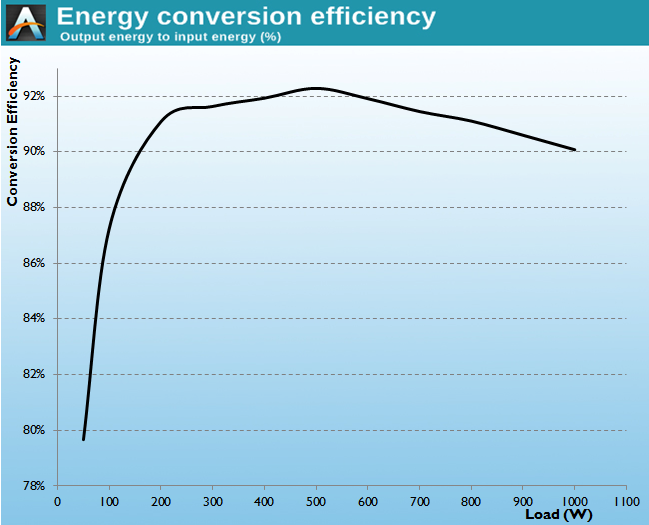
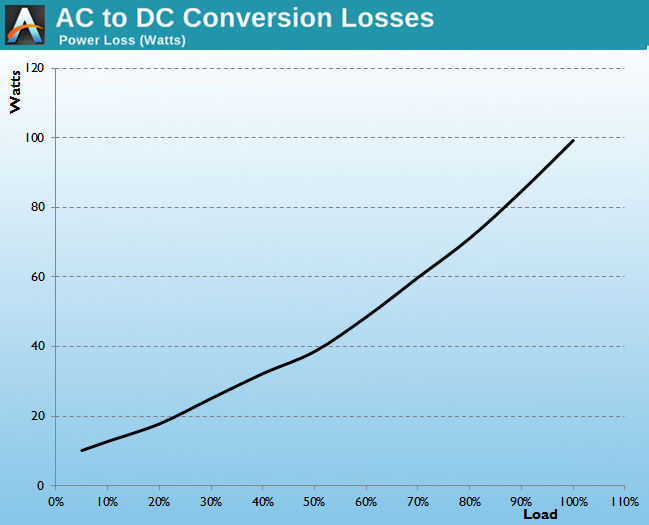
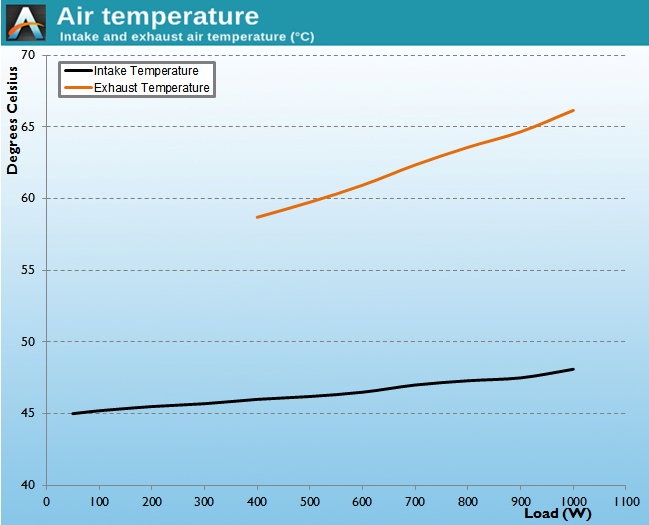
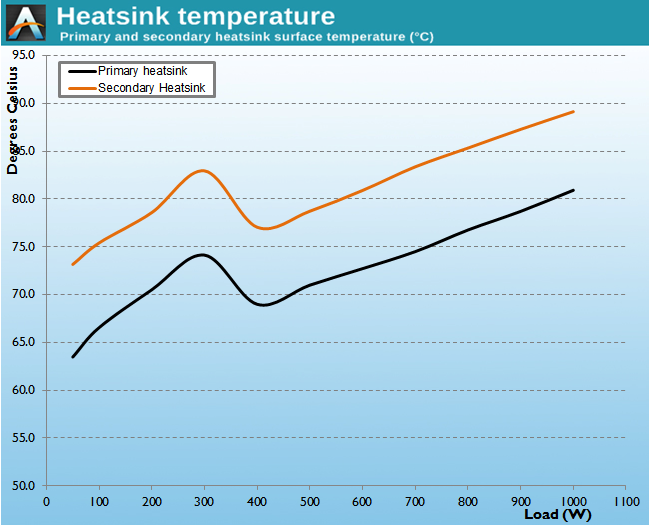
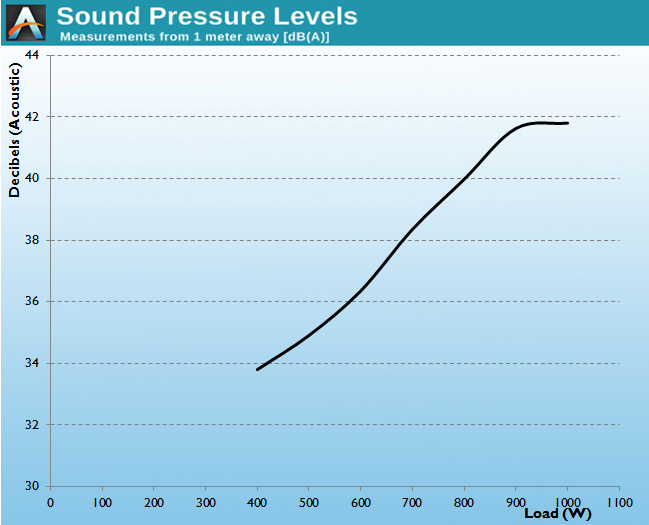








47 Comments
View All Comments
jonnyGURU - Wednesday, September 30, 2015 - link
Actually... you have it backwards. Look at an old RM review and an old HXi review if you don't believe me. NR135L is the rifle bearing fan. NR135P is the FDB fan.E.Fyll - Wednesday, September 30, 2015 - link
True. That was a mistake on my part. The NR135P is the FDB fan.E.Fyll - Wednesday, September 30, 2015 - link
The NR135P is an FDB fan. The RM1000x is advertised as having a rifle bearing fan, but my sample also had a NR135P inside it (FDB).I would assume that what happened is the exact opposite of what you are suggesting - Corsair ran out of NR135L's at some point and, instead of switching to something inferior, they chose to install a superior fan inside some of their RM1000x's.
jonnyGURU - Wednesday, September 30, 2015 - link
Exactly.extide - Wednesday, September 30, 2015 - link
So we can all put this to bed!buxe2quec - Thursday, October 1, 2015 - link
Some clarification about fluid dynamic bearings, rifle bearings, ... http://www.hardwaresecrets.com/the-truth-about-flu... It's quite complete, and shows how the naming scheme is not always coherent.Cow86 - Thursday, October 1, 2015 - link
Hmm, interesting...So then that means that buying a RMx series PSU you normally get an inferior fan to this review. I guess it should still be possible to draw conclusions from reviews of the old RM series on the fan's performance then though. Shame anyway, it robs us of a good direct comparison here. Thanks for the follow-up jonnyGURU!ruthan - Wednesday, September 30, 2015 - link
Are sure that fan will not spinning until 500W load, even in longer load period? Because of i have Seasonic semi passivelly cooled PSU and fan not spinning worked only on paper, there was some temperature trigger set prettty low, so fan was spinning even in 150W,200W load after few minutes regardless of fan mode switch (PSU was Platinum 860W).jonnyGURU - Wednesday, September 30, 2015 - link
The fan uses an algorithm of load, temperature and duration. Similar to the Seasonic. The marketing represents the fan speed at different loads at 25°C. If your ambient temperatures are higher, the fan will start sooner.Cellar Door - Thursday, October 1, 2015 - link
Seasonic has been doing smaller footprint PSUs for a while with a 'fan only when needed' switch for a while now. For ex. a 750 Gold unit would top out at 975watts and do stay in platinum efficiency for most of the time.Why are we getting all excited about a bearing technology 3 years after superior units jonnyGURU?
XFX units(based on them), were a steal..